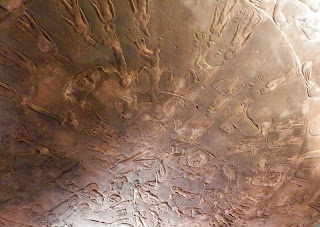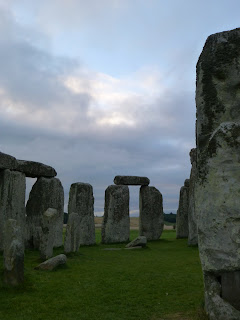Chaco Canyon
One of the most fascinating earth altars I've ever visited is Chaco Canyon. Tucked into the northwest corner of New Mexico are the ruins of a settlement of Puebloan peoples which date to 800-1200 AD. What makes these ruins interesting is how they are built to align with the movements of the light of the sun over the seasons.
The precision of the alignments at several different areas within the site illustrates that the people who built were very in tune with the equinox and solstice. Indeed, the site lends itself to an interpretation that it may have been an astrological observatory.
Pueblo Bonito, one of the largest of the structures boasting 700 rooms was built in a "D"-shaped configuration. Twice a year, as the sun rises and sets, the path follows the straight edge of the "D". In fact, this happens a few days in advance of the equinox, indicating perhaps a signal that it was time to do ceremony for the days leading up to the actual event.
The "D" shape can also be interpreted as a "half-moon" shape, and it is aligned with the cardinal directions, with the north-south line perfectly intersecting to "divide" the moon into quarters, while the east-west line of its opening forming the the straight line along which the equinox sun passes.
A video from the San Francisco Exploratorium explains how the people may have used large standing rocks or notches in the mountains on the horizon to identify the precise cardinal directions (about mid-way through the presentation the scientists explain how to use a basketball, some paper, paperclips and a light to demonstrate--great project for a middle school activity!).
We learn, on the Chaco Canyon website, that to the site builders, the cardinal directions "connect people, the seasons, the Sun and Moon's patterns, time, nature, the environment, the cosmos, and ceremonial systems. Observance of the cardinal directions and the Sun essentially ensured life by knowing when it was time to plant, harvest, and hunt for example. Pueblo Bonito is a physical manifestation of these ideas," explains Dr. Shelley Valdez, a member of the Pueblo Laguna Tribe.
Other indications in the canyon, which is registered as a World Heritage Site, support the observatory hypothesis (for no one truly knows the original inhabitants' intention). An artist, Anna Sofaer, studying the rock art in the canyon on solstice in 1978 made a great discovery regarding a double spiral carved into a rock wall. At the summer solstice, a "sun dagger" is formed by sunlight shining through the rocks that dissects the large spiral through its center, while at winter solstice there are two daggers that shine to bracket either side of the large spiral.
There's a great animation of this phenomenon you can watch here, although the actual sun dagger site is now inaccessible and it has sunk so that the light no longer follows the pattern it did when it was discovered. Luckily for us, there is a fabulous animated interactive model developed by The Soltice Project "Solar Dagger Explorer Exhibit" at the New Mexico Museum of Natural History and Science in Albuquerque, which I am really looking forward to seeing in person soon!
In another location, "Wijiji", the sunlight crosses a petroglyph of the sun, which was discovered by another artist, Janet Saad-Cook in 1931. And yet other petroglyphs appear to depict a supernova exploding and solar flare activity!
Tomorrow: What might the above concentric circular structure have been? It's another observatory at another location within the Chaco Canyon site.
Stay tuned for more! There's just too much about Chaco to post in one day!
Kaliani
 |
| Window on the Cosmos |
Pueblo Bonito, one of the largest of the structures boasting 700 rooms was built in a "D"-shaped configuration. Twice a year, as the sun rises and sets, the path follows the straight edge of the "D". In fact, this happens a few days in advance of the equinox, indicating perhaps a signal that it was time to do ceremony for the days leading up to the actual event.
The "D" shape can also be interpreted as a "half-moon" shape, and it is aligned with the cardinal directions, with the north-south line perfectly intersecting to "divide" the moon into quarters, while the east-west line of its opening forming the the straight line along which the equinox sun passes.
 |
| Pueblo Bonito |
We learn, on the Chaco Canyon website, that to the site builders, the cardinal directions "connect people, the seasons, the Sun and Moon's patterns, time, nature, the environment, the cosmos, and ceremonial systems. Observance of the cardinal directions and the Sun essentially ensured life by knowing when it was time to plant, harvest, and hunt for example. Pueblo Bonito is a physical manifestation of these ideas," explains Dr. Shelley Valdez, a member of the Pueblo Laguna Tribe.
 |
| Pueblo Bonito |
There's a great animation of this phenomenon you can watch here, although the actual sun dagger site is now inaccessible and it has sunk so that the light no longer follows the pattern it did when it was discovered. Luckily for us, there is a fabulous animated interactive model developed by The Soltice Project "Solar Dagger Explorer Exhibit" at the New Mexico Museum of Natural History and Science in Albuquerque, which I am really looking forward to seeing in person soon!
In another location, "Wijiji", the sunlight crosses a petroglyph of the sun, which was discovered by another artist, Janet Saad-Cook in 1931. And yet other petroglyphs appear to depict a supernova exploding and solar flare activity!
Tomorrow: What might the above concentric circular structure have been? It's another observatory at another location within the Chaco Canyon site.
 |
| Cycles of Time |
Kaliani


Comments